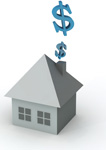Intro to "House Flipping; Calculate your Net Profit"
Try the calculator House Flipping; Calculate your Net Profit >
Buy, renovate and resale; is it a good investment?
 Renovating for profit, also known as flipping, involves buying a property, renovating it, and selling it shortly after at a higher price making a profit. It is an activity that has been recently highly mediatized with many different TV shows dedicated to the subject. On the shows, successful transactions are exposed using simplified math. However, flipping is a risky activity that can be demanding in time and energy, without any guarantee of making big returns. That's why it is important to calculate the potential profitability before getting into such a project.
Renovating for profit, also known as flipping, involves buying a property, renovating it, and selling it shortly after at a higher price making a profit. It is an activity that has been recently highly mediatized with many different TV shows dedicated to the subject. On the shows, successful transactions are exposed using simplified math. However, flipping is a risky activity that can be demanding in time and energy, without any guarantee of making big returns. That's why it is important to calculate the potential profitability before getting into such a project.
On top of evaluating the net profitability, you always have to take into consideration the opportunity cost. A return that turns out to be equivalent to what you would get from the stock market is not necessarily worth it. Investing your money in the stock market requires little personal effort, and it frees your time to work on other potential income. To avoid wasting time and money in a low yielding project, the first step is to know all the expenses involved.
Investment and expenses when flipping a property
The idea of renovating to cash a profit follows the market principle of buying a product, improving it, and reselling it at higher price shortly after. However, a real estate property is not a liquid asset, there is no incoming cash flow before its resale, and its purchase requires a high investment.
The first major disbursement you will need when flipping a property is the cash down on the mortgage balance. Banks will rarely finance 100% of the real estate value, but rather 80% to 95%, which can signify a first deposit of at least five digits. In addition, there are other expenses related to the purchase of a property, such as its inspection, notary fees and the transfer tax.
Only after covering these initial costs will the renovation expenses begin. There are two types of renovation expenses on a residential property: the cost of repairs and the cost of improvements, two very different things.
The cost of improvements are expenses that will increase the value of the property. For example: a new roof, new windows, an air conditioner installation or a new floor; all these expenses are deductible from capital gain tax and will increase the property’s value.
The costs of repairs are made to keep the assets already installed in good condition. This is general maintenance and will not increase the property’s value. Some examples would be: plumbing repairs, painting the walls, or cleaning the windows.
On top of these expenses, once you become owner, you have to disburse the monthly payments on your mortgage (both capital and interest). You must note that the interest portion is not recuperated from the property’s resale, as opposed to the capital portion. Other monthly expenses that need to be taken into consideration as well are: electricity, insurance, energy and property taxes (municipal and school), which also won't be recuperated in the resale of the property.
It is important to note that when you flip a property under your own company, you can actually write off all the current expenses (repairs, monthly expenses and interest on the mortgage) under the name of the company, and deduct them from the income tax. You will then benefit from a tax reduction and increase your profit.
Finally, the sale of the property comes with its own costs: realtor fees, publicity and the taxes on the capital gain will reduce your profit. Capital gain is the profit you get from a resale. It is the difference between the selling price, minus its related costs (realtor fees and publicity), and the purchase price including its related costs (notary fees, taxes, inspection) and the cost of improvements. Normally, only half of the tax rate will be applied on the capital gain, and it is possible to be exempt from it when living in the property.
House flipping and the return on investment
House flipping is an investment project where you provide an amount of money at the beginning, and plan to recuperate a bigger amount at the end. The amount invested is in all the expenses enumerated earlier, and the amount recuperated is the net profit on the property’s resale. When the aim is turning a profit, as is the case in property flipping, then you can only hope to resell the real estate asset rapidly enough in order to minimize drainage from interests and monthly expenses.
To measure a project’s success, we need to make a parallel between the total investment and the expenses, with the net profit upon its resale, based on the selling delay. By annualizing the rate of return, we can find out what your investment really brought. You can then compare it with the rate of return of other investment opportunities to judge it was worth it in the end.
Let's take an example where the total investment and expenses were $200,000.00 and the net selling profit is $250,000.00. If the whole process took 24 months, the annual percentage yield is 11.8%, which is a good return on the investment. If the sale was done in 12 months, we are now talking about a return of 25%, which is much better, and in 6 months, the effective annual rate would be 56.3%, an incredible return.
It is important to bear in mind the time and effort a project like this requires on your end. A rate of return of 10% can be interesting if you haven't done much effort. However, if you work many hours per week on the project, the 10% must include your salary, which necessarily will lower the rate of return on your investment.
In order to succeed in such a project, it is vital to lower the expenses as much as possible, and invest in key renovations (kitchen, bathroom, floors or windows, for example). For this reason, you often find real estate professionals such as realtors, renovation experts, and companies involved in this type of project. Realtors can save on the transaction fees, renovation experts can minimize expenses through the cost of renovations, and companies can save on income tax by declaring all current expenses in their financial statements. The winning combination would be to regroup these three into one organization.
Using the house flipping calculator
Before jumping on a house flipping project, the following calculator will help you judge its worthiness. Based on the selling price you expect and all the expenses, you will obtain the net profit and the rate of return of your investment. Always stay reasonable when you enter the selling price, because the average appreciation rate stays between 2% and 3% per year.
Try the calculator House Flipping; Calculate your Net Profit >




